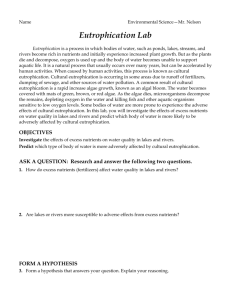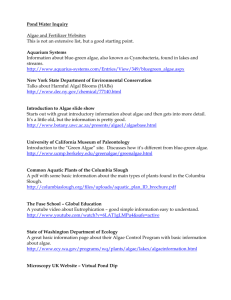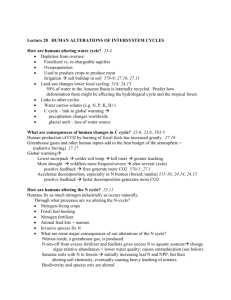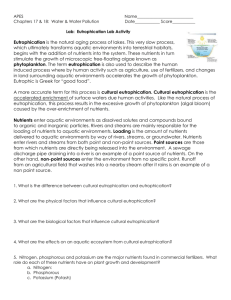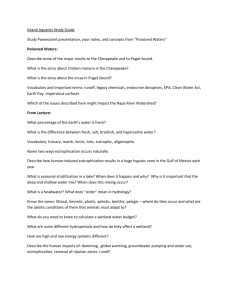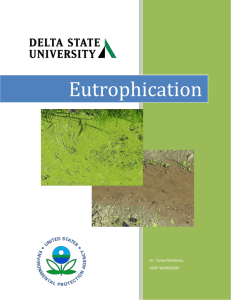01 - Crestwood Local Schools
advertisement
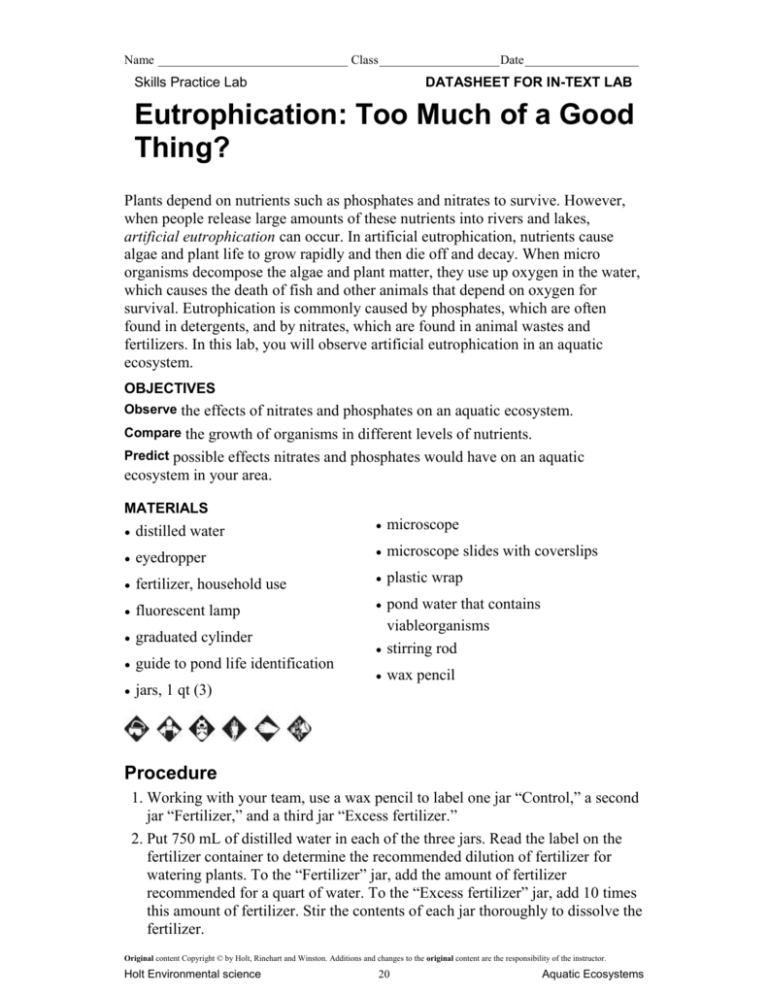
Name ______________________________ Class ___________________ Date __________________ Skills Practice Lab DATASHEET FOR IN-TEXT LAB Eutrophication: Too Much of a Good Thing? Plants depend on nutrients such as phosphates and nitrates to survive. However, when people release large amounts of these nutrients into rivers and lakes, artificial eutrophication can occur. In artificial eutrophication, nutrients cause algae and plant life to grow rapidly and then die off and decay. When micro organisms decompose the algae and plant matter, they use up oxygen in the water, which causes the death of fish and other animals that depend on oxygen for survival. Eutrophication is commonly caused by phosphates, which are often found in detergents, and by nitrates, which are found in animal wastes and fertilizers. In this lab, you will observe artificial eutrophication in an aquatic ecosystem. OBJECTIVES Observe the effects of nitrates and phosphates on an aquatic ecosystem. Compare the growth of organisms in different levels of nutrients. Predict possible effects nitrates and phosphates would have on an aquatic ecosystem in your area. MATERIALS • distilled water • microscope • eyedropper • microscope slides with coverslips • fertilizer, household use • plastic wrap • fluorescent lamp • pond water that contains • graduated cylinder • guide to pond life identification • jars, 1 qt (3) viableorganisms • stirring rod • wax pencil Procedure 1. Working with your team, use a wax pencil to label one jar “Control,” a second jar “Fertilizer,” and a third jar “Excess fertilizer.” 2. Put 750 mL of distilled water in each of the three jars. Read the label on the fertilizer container to determine the recommended dilution of fertilizer for watering plants. To the “Fertilizer” jar, add the amount of fertilizer recommended for a quart of water. To the “Excess fertilizer” jar, add 10 times this amount of fertilizer. Stir the contents of each jar thoroughly to dissolve the fertilizer. Original content Copyright © by Holt, Rinehart and Winston. Additions and changes to the original content are the responsibility of the instructor. Holt Environmental science 20 Aquatic Ecosystems Name ______________________________ Class ___________________ Date __________________ Eutrophication: Too Much of a Good Thing? continued 3. Obtain a sample of pond water. Stir it gently but thoroughly to ensure that the organisms in it are evenly distributed. Measure 100 mL of pond water into each of the three jars. 4. Cover each jar loosely with plastic wrap. Place all three jars about 20 cm from a fluorescent lamp. (Do not place the jars in direct sunlight, as this may cause them to heat up too much.) 5. Observe a drop of pond water from your sample, under the microscope. In the space below, draw at least four different organisms that you see. Determine whether the organisms are algae (usually green) or consumers (usually able to move). Describe the total number and type of organisms that you see _______________________________________________________________ _______________________________________________________________ _______________________________________________________________ 6. Based on what you have learned about eutrophication, make a prediction about how the pond organisms will grow in each of the three jars. _______________________________________________________________ _______________________________________________________________ _______________________________________________________________ Original content Copyright © by Holt, Rinehart and Winston. Additions and changes to the original content are the responsibility of the instructor. Holt Environmental science 21 Aquatic Ecosystems Name ______________________________ Class ___________________ Date __________________ Eutrophication: Too Much of a Good Thing? continued 7. Observe the jars when you first set them up and at least once every three days for the next 3 weeks. Make a data table to record the date, color, odor, and any other observations you make for each jar. 8. When life-forms begin to be visible in the jars (probably after a week), use an eye dropper to remove a sample of organisms from each jar and observe the sample under the microscope. Record your observations. _______________________________________________________________ _______________________________________________________________ _______________________________________________________________ 9. At the end of your 3-week observation period, again remove a sample from each jar and observe it under the microscope. Draw at least four of the most abundant organisms that you see, and describe how the number and type of organisms have changed. _______________________________________________________________ _______________________________________________________________ _______________________________________________________________ Analysis 1. Describing Events After three weeks, which jar shows the most abundant growth of algae? What may have caused this growth? _______________________________________________________________ _______________________________________________________________ _______________________________________________________________ 2. Analyzing Data Did you observe any effects on organisms other than algae in the jar that had the most abundant algae growth? Explain. _______________________________________________________________ _______________________________________________________________ _______________________________________________________________ Original content Copyright © by Holt, Rinehart and Winston. Additions and changes to the original content are the responsibility of the instructor. Holt Environmental science 22 Aquatic Ecosystems Name ______________________________ Class ___________________ Date __________________ Eutrophication: Too Much of a Good Thing? continued Conclusions 3. Applying Conclusions Did your observations match your predictions? Explain. _______________________________________________________________ _______________________________________________________________ _______________________________________________________________ 4. Drawing Conclusions How can artificial eutrophication be prevented in natural water bodies? _______________________________________________________________ _______________________________________________________________ Extension 1. Designing Experiments Modify the experiment by using household dishwashing detergent instead of household fertilizer. Are the results different? _______________________________________________________________ _______________________________________________________________ 2. Research and Communications Research the watersheds that are located close to your area. How might activities such as farming and building affect water sheds? _______________________________________________________________ _______________________________________________________________ Original content Copyright © by Holt, Rinehart and Winston. Additions and changes to the original content are the responsibility of the instructor. Holt Environmental science 23 Aquatic Ecosystems TEACHER RESOURCE PAGE Skills Practice Lab DATASHEET FOR IN-TEXT LAB Eutrophication: Too Much of a Good Thing? Teacher Notes TIME REQUIRED One 45-minute period for set-up, plus follow-up observations over a 3-week period SKILLS ACQUIRED Predicting Designing experiments Experimenting Collecting data Interpreting Organizing and Analyzing Data RATING Teacher Prep–2 Student Set-Up–2 Concept Level–3 Clean Up–2 THE SCIENTIFIC METHOD Form a Hypothesis Students predict how pond organisms will grow in Procedure step 6. Analyze Results Analysis question 2 asks student to analyze data to determine whether organisms other than algae were affected by abundant algae growth. Draw Conclusions Conclusions question 4 requires students to draw conclusions about preventing eutrophication. MATERIALS You may substitute plastic soda bottles for the empty jars. Collect a 5 L water sample from a local, natural, open watershed. When collecting pond water, plankton nets are helpful for concentrating micro organisms in the sample. Make sure the sample includes some algae and a small amount of mud. Preview the sample to be sure that all desired organisms are identifiable. As an alternative to collecting pond samples, you might leave tap water in a container for 24 hours to allow any chlorine to dissipate or use a chlorine neutralizer for aquariums. Add a stock algae culture such as Spirogyra or Chlorella to the water. The stock culture will not provide the natural diversity that natural pond water would provide, but it will enable students to observe algae growth and will model the results of eutrophication. Original content Copyright © by Holt, Rinehart and Winston. Additions and changes to the original content are the responsibility of the instructor. Holt Environmental science 52 Aquatic Ecosystems TEACHER RESOURCE PAGE Eutrophication: Too Much of a Good Thing? continued SAFETY CAUTIONS Encourage students to wear comfortable, seasonal clothing. Old clothes and waterproof shoes or boots are advisable when working in aquatic habitats. Students should wear goggles, gloves, and protective clothing while handling chemicals such as fertilizer and unknown pond organisms. Be sure to review the safety cautions on the container of household fertilizer. Students should wash their hands carefully after handling the pond water samples. Clean the work area with disinfectant after completing the investigation. DISPOSAL Pond water samples that have not been contaminated with chemicals could be returned to the original collection site. However, you do not want to pollute the aquatic ecosystem with the fertilizer and detergents used in the experimental portion of this investigation. Small quantities may be safely flushed down the drain. TECHNIQUES TO DEMONSTRATE Depending on your students’ level of experience with microscope techniques, you may wish to demonstrate how to make a wet mount. Place a drop of pond water in the well of the slide with the dropper. Pick up a cover slip and place one edge on the slide. Slowly lower the other edge so that the water spreads out under it. Be careful not to trap bubbles of air beneath the cover slip. TIPS AND TRICKS You may wish to prepare the containers on the appropriate number of days ahead of time so students can complete this investigation during one class period. An alternative method for this lab would be to conduct the experiment using gradually larger concentrations of fertilizer, such as 1X, 2X, 3X, 4X and so on. This method would better illustrate the cycle of growth that leads to eutrophication. Original content Copyright © by Holt, Rinehart and Winston. Additions and changes to the original content are the responsibility of the instructor. Holt Environmental science 53 Aquatic Ecosystems TEACHER RESOURCE PAGE Name ______________________________ Class ___________________ Date __________________ Skills Practice Lab DATASHEET FOR IN-TEXT LAB Eutrophication: Too Much of a Good Thing? Plants depend on nutrients such as phosphates and nitrates to survive. However,when people release large amounts of these nutrients into rivers and lakes, artificial eutrophication can occur. In artificial eutrophication, nutrients cause algae and plant life to grow rapidly and then die off and decay. When micro organisms decompose the algae and plant matter, they use up oxygen in the water, which causes the death of fish and other animals that depend on oxygen for survival. Eutrophication is commonly caused by phosphates, which are often found in detergents, and by nitrates, which are found in animal wastes and fertilizers. In this lab, you will observe artificial eutrophication in an aquatic ecosystem. OBJECTIVES Observe the effects of nitrates and phosphates on an aquatic ecosystem. Compare the growth of organisms in different levels of nutrients. Predict possible effects nitrates and phosphates would have on an aquatic ecosystem in your area. MATERIALS • distilled water • eyedropper • • • • • fertilizer, household use fluorescent lamp graduated cylinder guide to pond life identification jars, 1 qt (3) • microscope • microscope slides with coverslips • plastic wrap • pond water that contains viable organisms • stirring rod • wax pencil Procedure 1. Working with your team, use a wax pencil to label one jar “Control,” a second jar “Fertilizer,” and a third jar “Excess fertilizer.” 2. Put 750 mL of distilled water in each of the three jars. Read the label on the fertilizer container to determine the recommended dilution of fertilizer for watering plants. To the “Fertilizer” jar, add the amount of fertilizer recommended for a quart of water. To the “Excess fertilizer” jar, add 10 times this amount of fertilizer. Stir the contents of each jar thoroughly to dissolve the fertilizer. Original content Copyright © by Holt, Rinehart and Winston. Additions and changes to the original content are the responsibility of the instructor. Holt Environmental science 54 Aquatic Ecosystems TEACHER RESOURCE PAGE Name ______________________________ Class ___________________ Date __________________ Eutrophication: Too Much of a Good Thing? continued 3. Obtain a sample of pond water. Stir it gently but thoroughly to ensure that the organisms in it are evenly distributed. Measure 100 mL of pond water into each of the three jars. 4. Cover each jar loosely with plastic wrap. Place all three jars about 20 cm from a fluorescent lamp. (Do not place the jars in direct sunlight, as this may cause them to heat up too much.) 5. Observe a drop of pond water from your sample, under the microscope. In the space below, draw at least four different organisms that you see. Determine whether the organisms are algae (usually green) or consumers (usually able to move). Describe the total number and type of organisms that you see. Answers may vary.____________________________________________________ ____________________________________________________________________ ____________________________________________________________________ 6. Based on what you have learned about eutrophication, make a predictionabout how the pond organisms will grow in each of the three jars. Answers may vary.____________________________________________________ ____________________________________________________________________ ____________________________________________________________________ Original content Copyright © by Holt, Rinehart and Winston. Additions and changes to the original content are the responsibility of the instructor. Holt Environmental science 55 Aquatic Ecosystems TEACHER RESOURCE PAGE Name ______________________________ Class ___________________ Date __________________ Eutrophication: Too Much of a Good Thing? continued 7. Observe the jars when you first set them up and at least once every three days for the next 3 weeks. Make a data table to record the date, color, odor, and any other observations you make for each jar. 8. When life-forms begin to be visible in the jars (probably after a week), use an eye dropper to remove a sample of organisms from each jar and observe the sample under the microscope. Record your observations. Answers may vary.____________________________________________________ ____________________________________________________________________ ____________________________________________________________________ 9. At the end of your 3-week observation period, again remove a sample from each jar and observe it under the microscope. Draw at least four of the most abundant organisms that you see, and describe how the number and type of organisms have changed. Answers may vary.____________________________________________________ ____________________________________________________________________ ____________________________________________________________________ Analysis 1. Describing Events After three weeks, which jar shows the most abundant growth of algae? What may have caused this growth? Answers may vary. The jar with excess fertilizer should show the most________ growth. The extra fertilizer stimulated additional plant growth.______________ 2. Analyzing Data Did you observe any effects on organisms other than algae in he jar that had the most abundant algae growth? Explain. Answers may vary. The jar with the most growth should have the fewest_______ number of microorganisms._____________________________________________ Original content Copyright © by Holt, Rinehart and Winston. Additions and changes to the original content are the responsibility of the instructor. Holt Environmental science 56 Aquatic Ecosystems TEACHER RESOURCE PAGE Name ______________________________ Class ___________________ Date __________________ Eutrophication: Too Much of a Good Thing? continued Conclusions 3. Applying Conclusions Did your observations match your predictions? Explain. Answers may vary.____________________________________________________ ____________________________________________________________________ ____________________________________________________________________ 4. Drawing Conclusions How can artificial eutrophication be prevented in natural water bodies? Artificial eutrophication can be prevented by controlling the application_______ of fertilizers in areas where runoff is common___________________________. Extension 1. Designing Experiments Modify the experiment by using household dishwashing detergent instead of household fertilizer. Are the results different? Answers may vary. The samples with dishwashing detergent and_____________ excess dish washing detergent should both show no additional growth._________ 2. Research and Communications Research the watersheds that are located close to your area. How might activities such as farming and building affect water sheds? Answers may vary.____________________________________________________ ____________________________________________________________________ ____________________________________________________________________ Original content Copyright © by Holt, Rinehart and Winston. Additions and changes to the original content are the responsibility of the instructor. Holt Environmental science 57 Aquatic Ecosystems
